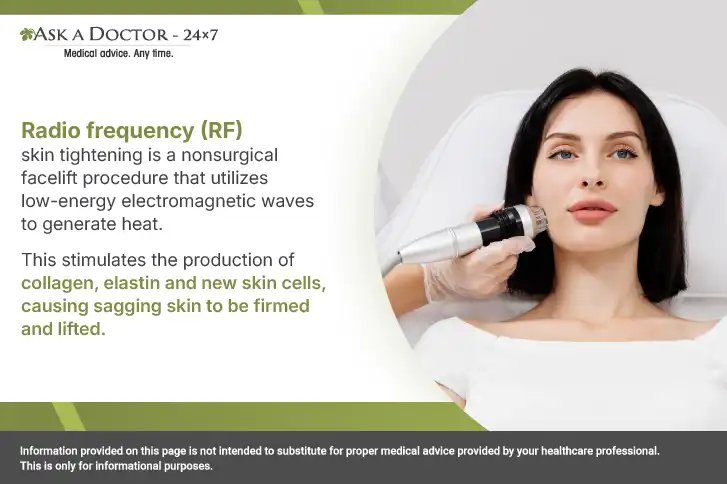Radiofrequency Skin Tightening: Benefits, Potential Side Effects, And Who Should Go For It?
With the growing demand to postpone the ageing process, skin rejuvenation techniques, particularly non-invasive cosmetic technology, are flourishing. One such technique is radiofrequency (RF) skin tightening. It is a non-surgical cosmetic procedure for skin tightening, giving a youthful appearance. This procedure employs radio waves to heat the skin's deeper layers, promoting the creation of collagen and producing smoother, tighter skin. It's a well-liked choice for people who want to improve the texture of their skin overall and lessen wrinkles and sagging skin without having surgery.
This procedure is a fantastic substitute for surgery as it is usually harmless. A few side effects include moderate redness, swelling, and rare instances of burns or changes in the skin pigmentation. It works well for individuals with mild to moderate skin laxity and for those who prefer a less invasive procedure.
In this blog, we’re going to look at how radiofrequency therapy works and what potential benefits it has for your skin, along with its side effects.
What is the Radiofrequency Skin Tightening Procedure?

In the radiofrequency therapy process, electromagnetic waves are emitted by a specialised instrument, penetrating the deeper layers of the skin. Skin tightening and rejuvenation result from this heat's stimulation of collagen and elastin (proteins that are crucial for skin elasticity and firmness), promoting skin tightening and rejuvenation. This procedure is non-invasive (does not involve incisions or injections) and quite quick; people can return to their normal activities right away.
Benefits of Radiofrequency Skin Tightening
Some of the benefits of RF skin tightening include:
- Non-surgical skin tightening: RF therapy provides a non-invasive alternative to surgery for treating wrinkles and drooping skin.
- Collagen stimulation: The body's natural creation of collagen is triggered by the heat produced by radiofrequency waves, which results in long-term skin tightening and renewal.
- Improved skin texture: RF treatments can make skin smoother and more even by reducing the visibility of rough skin, acne scars, and enlarged pores.
- Corrects sun damage: Degradation and disarray of the collagen fibres in your skin can result from exposure to ultraviolet (UV) radiation. In individuals with mild to moderate sun damage, RF therapy can show clinically significant improvements in a few months of treatment.
- Face slimming: According to research, following 5 weeks of RF therapy, 90% of the women experienced a reduction in face fat in the area of the treatment.
- Minimal discomfort and recovery time: Most people have little to no discomfort both during and after the surgery.
- Ideal for a range of skin types: All skin types, even sensitive skin, can benefit from RF skin tightening, which is generally safe and effective.
- Versatile treatment: RF can be used on the face, neck, and body to treat a range of issues, including cellulite, sagging skin, and wrinkles.
- Combinable with further therapies: For better outcomes, RF therapy can be used in conjunction with other cosmetic procedures such as microneedling (collagen induction therapy).
- Boosted confidence: Improves your sense of self-worth and confidence by making you feel and look your best. Transforming your skin to be tighter, smoother, and younger-looking.
Side Effects of Radiofrequency Skin Tightening
RF skin tightening is usually safe when performed by a certified surgeon or cosmetologist. If the procedure is incorrectly performed, it’s possible to get burned along with other side effects, like:
- Redness and swelling are typical side effects that usually subside within a few hours to a few days.
- Mild discomfort: During the procedure, some people may feel a slight tingling or discomfort.
- Rare adverse effects: Burns, blisters, or changes in skin pigmentation (hyperpigmentation or hypopigmentation) are uncommon side effects of RF treatments.
- Scarring or infection: Although uncommon, these outcomes are possible, particularly if appropriate aftercare guidelines are not followed.
Who should consider RF skin tightening?
The following individuals should take RF skin tightening into consideration:
- Individuals whose face, neck, or body exhibits mild to moderate skin laxity.
- Those looking for a non-surgical substitute for a facelift or other surgical operations.
- Those who desire speedy recuperation and little rest.
- Individuals who want to minimise wrinkles and enhance the texture of their skin. Those with sensitive skin types.
Conclusion
The amount and density of collagen fibres in your skin decrease with age. RF therapy is a safe procedure for treating mild to moderate indications of ageing. RF therapy heats the dermis, the deepest layer of your skin, using low-intensity radiation. This heat helps stimulate the collagen to enhance the appearance of wrinkles and sagging skin.
Healthcare providers like dermatologists, plastic surgeons and cosmetic surgeons are certified to perform radiofrequency skin tightening. It is an outpatient procedure (one can go home after the treatment) that usually takes up to an hour, depending on the treatment area. You can consult your dermatologist for a consultation and to discuss the treatment options.
Ask a Doctor facilitates online consultation-24x7, you can send questions related to radiofrequency skin tightening to a Dermatologist, and they will reply within minutes. You can also send in your questions to Ask a Specialist on all health-related matters. Ask now!
Recently Answered Questions Related to Radiofrequency Skin Tightening
- What Are The Side Effects of Radio Frequency Treatment?
- Does Radio Frequency Treatment Help Cure Nerve Blocks?
- Is Cryo Ablation Or Radiofrequency Ablation Better For Atrial Fib?
- Would Pain Be Worse After I Had Radiofrequency Ablation Than How It Is Now?
- What Causes Severe Back Pain After Radiofrequency Ablation?
- Is Radiofrequency Neurotomy Painful?
- Wart Removed From The Face. Taking Antibiotics And Aciloc. Proper Medication?
- What Is Radiofrequency Ablation?
Disclaimer: Information provided on this page is not intended to substitute for proper medical advice provided by your healthcare professional. This is only for informational purposes.
Ask a Specialist
Recent Questions


